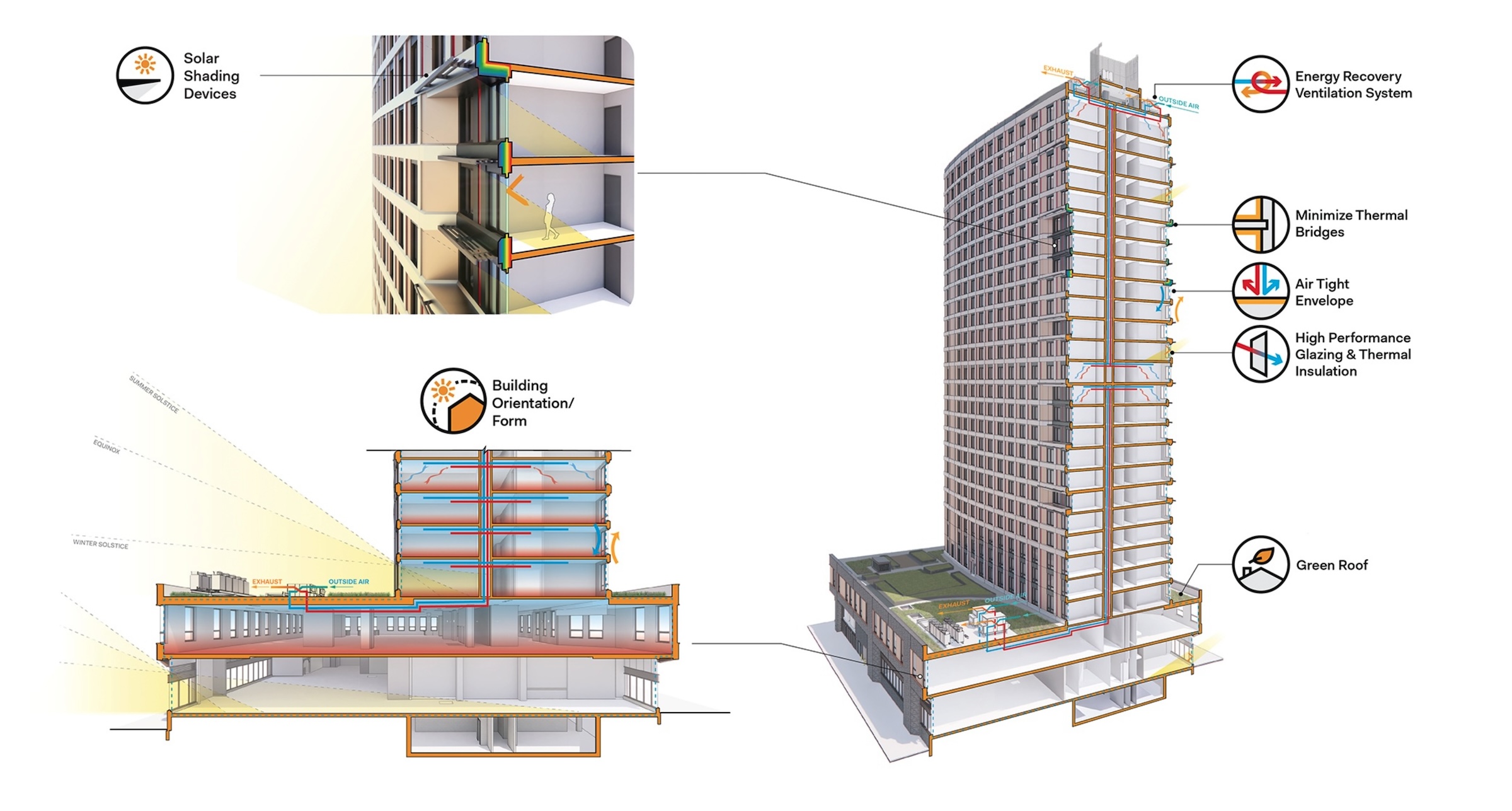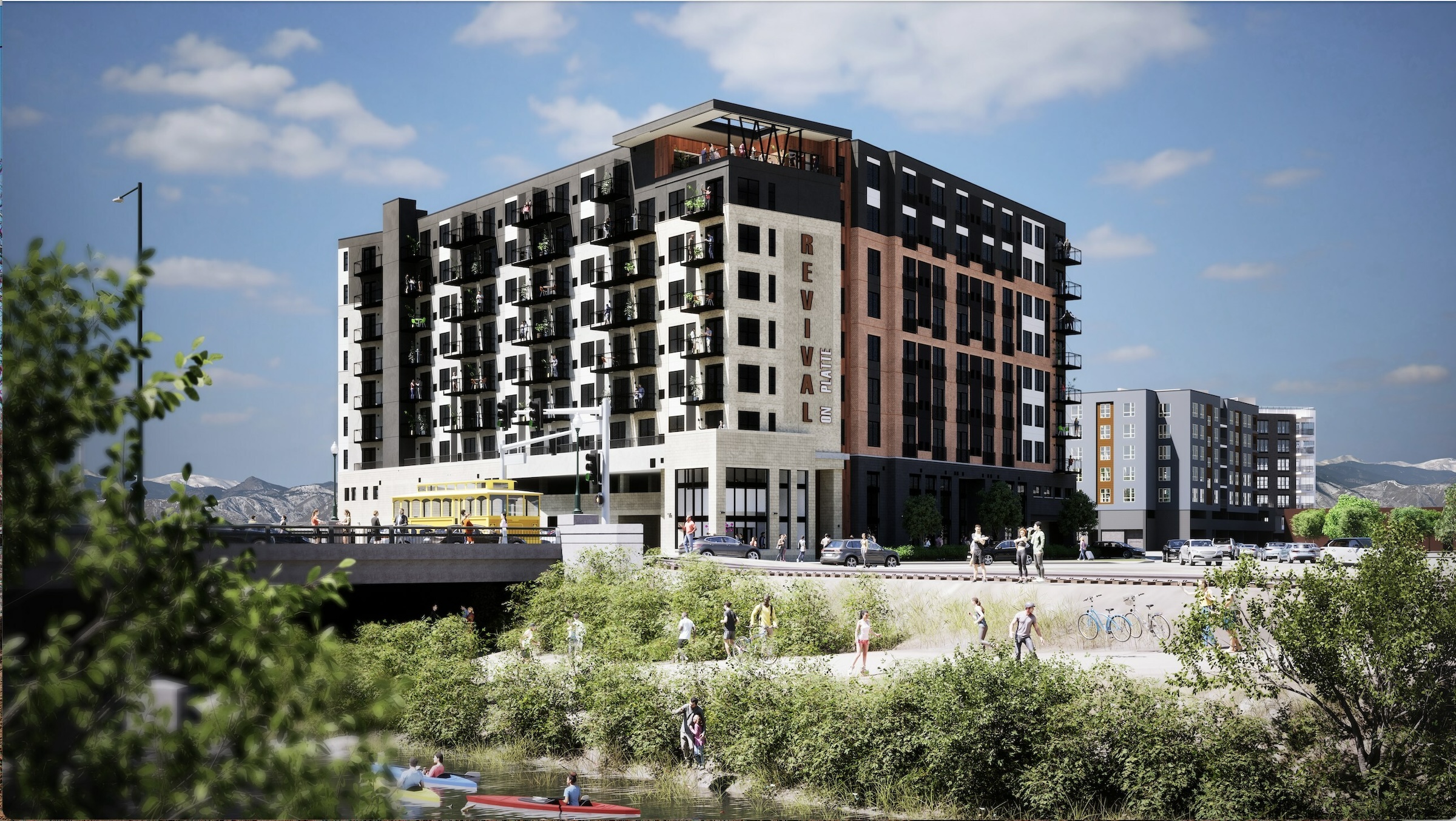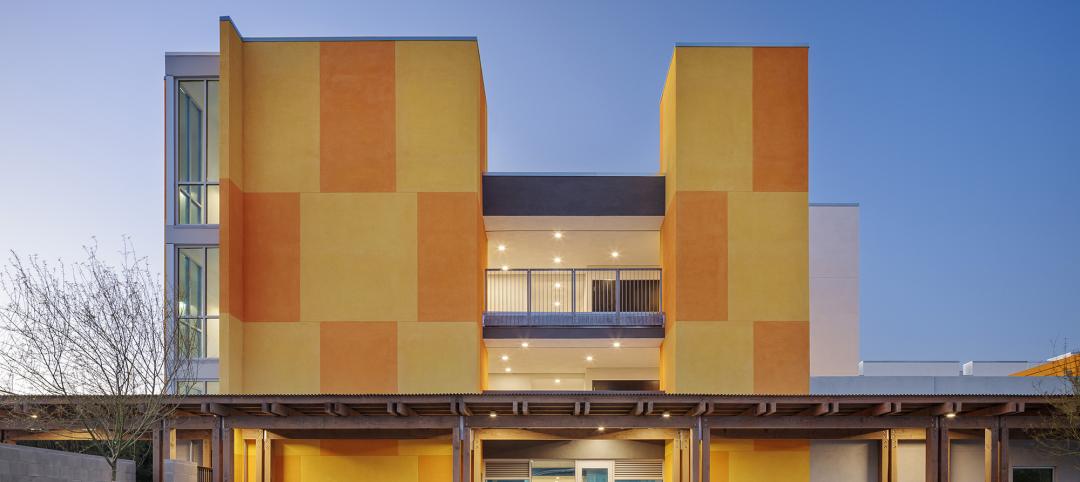Of the 553 AEC firms to participate in Building Design+Construction’s 2023 Giants 400 survey, 394 companies reported revenue from designing or building multifamily housing projects, including apartments, condominiums, senior living facilities, and student housing complexes.
Collectively, the 2023 Multifamily Giants were responsible for more than half of all U.S. multifamily construction work in 2022—possibly upwards of 60% of the U.S. market. The 120 construction firms alone reported $28.34 billion in revenue (i.e., construction value put in place) from multifamily work, or about a quarter of all multifamily construction work last year.
In all, the 274 design firms (architects, engineers, AEs, and EAs) reported just shy of $3 billion in revenue from multifamily buildings work, which represents anywhere from $35 billion to $40 billion in construction value put in place, depending on the design fees.
Needless to say, the Multifamily Giants have a sizable footprint in the multifamily housing market. Here’s a look at the top innovations reported by the 2023 Multifamily Giants:
Arcadis North America launched its Radius concept for senior living developments. The approach utilizes emerging technologies like artificial intelligence, the Internet of Things, sensors, 5G technology, and nano technology to provide 360-degree care to individuals in the privacy and comfort of their own home. “Through the seamless implementation of a home health ‘kit of parts’ into an adaptable universal floor plan, Radius allows space for dignity, aging in place, and independence for a population that is traditionally reliant on in-person appointments, bedside nursing, and medication management,” according to the firm.
BAR Architects & Interiors partnered with Holmes (structural and fire/life safety engineer), Interface Engineering (MEP), TBD Consultants (cost), and Plant Construction to develop Office 2 Housing Research, a report that explores opportunities and challenges in converting office buildings to housing. The research evaluates five existing buildings of different eras, locations, and construction types to assess the pros and cons of adaptive reuse for housing.
Related content: 2023 Multifamily Housing Design and Construction Giants Rankings:
Multifamily — All Multifamily Facilities Work
Top 190 Multifamily Sector Architecture and AE Firms — All Multifamily Facilities Work
Top 75 Multifamily Sector Engineering and EA Firms — All Multifamily Facilities Work
Top 115 Multifamily Sector Contractors and CM Firms — All Multifamily Facilities Work
Multifamily — Apartments, Condominiums
Top 160 Multifamily Sector Architecture and AE Firms — Apartments, Condominiums Work
Top 70 Multifamily Sector Engineering and EA Firms — Apartments, Condominiums Work
Top 100 Multifamily Sector Contractors and CM Firms — Apartments, Condominiums Work
Multifamily — Senior Living Facilities
Top 80 Multifamily Sector Architecture and AE Firms — Senior Living Facilities
Top 40 Multifamily Sector Engineering and EA Firms — Senior Living Facilities
Top 60 Multifamily Sector Contractors and CM Firms — Senior Living Facilities
Multifamily — Student Housing Facilities
Top 90 Multifamily Sector Architecture and AE Firms — Student Housing Facilities
Top 30 Multifamily Sector Engineering and EA Firms — Student Housing Facilities
Top 40 Multifamily Sector Contractors and CM Firms — Student Housing Facilities
BASE4 has introduced Design PLUS, an “all-services-in-house where we’ll help the client evaluate the best way to build, what materials are the best fit, which prefab applications are appropriate, and more,” according to the firm, which specializes in prefab construction methods for multifamily and hotel projects.
In Philadelphia, BKV Group employed light gauge metal prefab construction for the Northern Liberties mixed-use/multifamily development. The approach reduced construction time by 10-15% and helped achieve a density of 300 units per acre at a lower cost per unit when compared to traditional construction techniques, according to the firm.
To help mitigate the impacts from material price volatility and supply chain issues, Bozzuto Construction employs warehousing of materials and systems on select projects. It has also worked to condense the buyout phase from 270 days to 60 days. “We expect high material volatility to continue for at least the next eight months, so we are continuously identifying and evaluating other innovative strategies that we can implement to execute buyout with the highest efficiency,” says the firm.
CetraRuddy Architecture is designing the nation’s largest-ever commercial-to-residential conversion: the 1.1 million-sf 25 Water Street project in Manhattan’s Financial District. Dealing with large floor plates is one of the toughest challenges when converting office space to multifamily housing. For this 1,300-unit project, the project team is cutting two courtyards into the center of the building and removing floor area, which is redistributed to the top of the structure.
Curtis + Ginsberg Architects is steering multifamily clients toward all-electric, electric-ready, and Passive House projects, to help reduce the use of fossil fuels and carbon footprint, and as a hedge against future energy cost increases. This push includes the electrification of large existing multifamily developments, ranging in size from 12- to 200-unit buildings throughout New York City. As a result, some 5,400 units have been converted to all-electric and/or Passive House so far, says the firm.
Dattner Architects is pushing the boundaries of Passive House design for multifamily work. The firm had four projects receive Passive House Certification in 2022, including the 26-story, 300,000-sf 425 Grand Concourse in the Bronx, N.Y., one of the largest Passive House projects in North America to date. “This benchmark sustainable project provides a model for healthy living environments in a district with one of the worst childhood asthma rates in the country. Each apartments’ living rooms and bedrooms directly receives filtered, ventilated air, increasing interior comfort and air quality,” say the firm. Expansive windows provide a generous amount of daylight into the apartments while balancing the window to wall ratio that is critical to achieving Passive House performance levels.

To help its developer clients build market rate and affordable housing in an economy with with ever-rising construction costs and interest rates, Dwell Design Studio is using prototyping to streamline the design and development process, and to create highly efficient designs that can be adapted to a variety of sites and circumstances. The firm is laser focused on designing highly efficient floor plates that maximize the building footprint allowable within building code limitations across the country, and streamlining residential unit designs with standardized kitchen and bathroom layouts. The result: 85-90% building efficiency on its recent multifamily projects.
Humphreys and Partners Architects delivered its most efficient housing product to date, a micro-unit community situated on 0.54 acres in Nashville, Tenn. The short-term rental community caters to an emerging demographic of traveling professionals who need the comforts of home without the additional square footage. The development offers residents ultra-efficient studio floor plans ranging from 378 sf to 433 sf, with a thoughtful interior design with custom flush cabinetry, nimble bedrooms, and blended kitchen and living room space.
On the affordable housing front, KGD Architecture has developed design and delivery solutions that allow its developer clients to utilize both low-income housing tax credits and tax-exempt private-activity bonds to finance new construction and rehab projects. Case in point: Dominion Square, the first 100%-affordable housing multifamily development in Tysons, Va., providing 500-plus units affordable to households earning 60% of the area median income or less. The project includes a multilevel community center that will enable its residents to benefit directly from the county’s own community services for their health and well-being.
Mortenson continues to push the limits of offsite construction for multifamily projects. The construction giant partnered with its subsidiary manufacturing company, BLUvera, on the eight-story, 200-unit Revival on Platte project in Denver. The project features panels that arrived on site with roughed-in plumbing, mechanical, and finished exterior façades. “While we have many completed cold-formed steel projects, this integration of plumbing, mechanical, and exterior façade represents a significant leap forward in our quest to design and manufacture full building and enclosure systems in a factory setting,” according to the firm.
Related Stories
MFPRO+ News | May 20, 2024
Florida condo market roiled by structural safety standards law
A Florida law enacted after the Surfside condo tower collapse is causing turmoil in the condominium market. The law, which requires buildings to meet certain structural safety standards, is forcing condo associations to assess hefty fees to make repairs on older properties. In some cases, the cost per unit runs into six figures.
Mass Timber | May 17, 2024
Charlotte's new multifamily mid-rise will feature exposed mass timber
Construction recently kicked off for Oxbow, a multifamily community in Charlotte’s The Mill District. The $97.8 million project, consisting of 389 rental units and 14,300 sf of commercial space, sits on 4.3 acres that formerly housed four commercial buildings. The street-level retail is designed for boutiques, coffee shops, and other neighborhood services.
Affordable Housing | May 14, 2024
Brooklyn's colorful new affordable housing project includes retail, public spaces
A new affordable housing development located in the fastest growing section of Brooklyn, N.Y., where over half the population lives below the poverty line, transformed a long vacant lot into a community asset. The Van Sinderen Plaza project consists of a newly constructed pair of seven-story buildings totaling 193,665 sf, including 130 affordable units.
MFPRO+ News | May 13, 2024
Special multifamily report indicates ‘two supply scenarios’
Could we be headed towards a “period of stagflation?” That's the question Andrew Semmes, Senior Research Analyst, poses in the Matrix May 2024 Multifamily Rent Forecast update.
MFPRO+ News | May 10, 2024
HUD strengthens flood protection rules for new and rebuilt residential buildings
The U.S. Department of Housing and Urban Development (HUD) issued more stringent flood protection requirements for new and rebuilt homes that are developed with, or financed with, federal funds. The rule strengthens standards by increasing elevations and flood-proofing requirements of new properties in areas at risk of flooding.
Adaptive Reuse | May 9, 2024
Hotels now account for over one-third of adaptive reuse projects
For the first time ever, hotel to apartment conversion projects have overtaken office-to-residential conversions.
Mass Timber | May 8, 2024
Portland's Timberview VIII mass timber multifamily development will offer more than 100 affordable units
An eight-story, 72,000-sf mass timber apartment building in Portland, Ore., topped out this winter and will soon offer over 100 affordable units. The structure is the tallest affordable housing mass timber building and the first Type IV-C affordable housing building in the city.
MFPRO+ News | May 8, 2024
Multifamily rent growth approaches peak levels in April 2024
In its latest multifamily report, Yardi Matrix finds that the national average rent has increased for the second month in a row.
Senior Living Design | May 7, 2024
Living community opens for seniors seeking affordable housing
San Diego-based nonprofit affordable housing developer Community HousingWorks (CHW) celebrates the opening of Puesta del Sol Apartments, a new development with 59 apartments for adults 55 years and older.
Student Housing | May 3, 2024
Student housing construction dips in the first quarter of 2024
Investment in college dorms dipped slightly in the first quarter of 2024, but remains higher than a year ago.


















